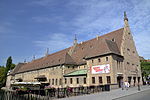Musée alsacien (Strasbourg)

The Musée alsacien (Alsatian museum) is a museum in Strasbourg in the Bas-Rhin department of France. It opened on 11 May 1907 and is dedicated to all aspects of (mostly rural) daily life in pre-industrial and early industrial Alsace. It contains over 5000 exhibits and is notable for the reconstruction of the interiors of several traditional houses. It also features a rich collection of artifacts documenting the everyday life of Alsatian Jews. The museum is located in several Renaissance timber framed houses on the Quai Saint-Nicolas, on the banks of the Ill river. In 1917 it was bought by the city of Strasbourg. Another, smaller, Musée alsacien exists in the city of Haguenau, 30 kilometers north of Strasbourg.
Excerpt from the Wikipedia article Musée alsacien (Strasbourg) (License: CC BY-SA 3.0, Authors, Images).Musée alsacien (Strasbourg)
Quai Saint-Nicolas, Strasbourg Krutenau
Geographical coordinates (GPS) Address Nearby Places Show on map
Geographical coordinates (GPS)
| Latitude | Longitude |
|---|---|
| N 48.579166666667 ° | E 7.7505555555556 ° |
Address
Quai Saint-Nicolas 24
67065 Strasbourg, Krutenau
Grand Est, France
Open on Google Maps









